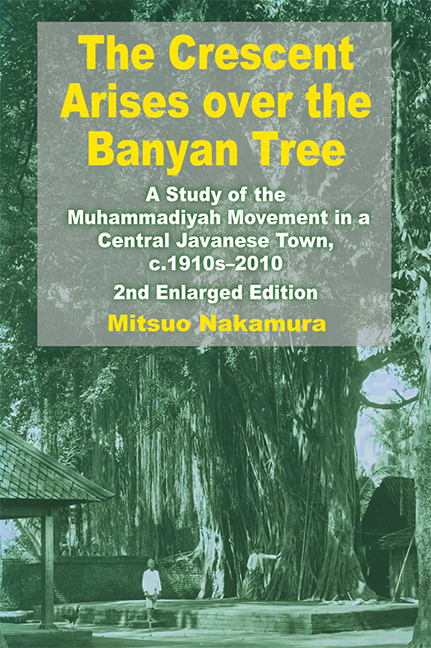 The Crescent Arises over the Banyan Tree
The Crescent Arises over the Banyan Tree Published online by Cambridge University Press: 21 October 2015
The first edition of this book, published by Gadjah Mada University Press in 1983, was a significant landmark in the study of Indonesian — especially Javanese — society. This was originally a Ph.D. thesis in anthropology submitted to Cornell University, one that had been inspired to a considerable degree by Clifford Geertz's path-breaking work The Religion of Java. That was based on fieldwork done in 1953–54 and was published in 1960. Nakamura's fieldwork was done nearly two decades later and, whereas Geertz and his colleagues had worked in the East Javanese town of Pare (dubbed “Modjokuto” in their publications), Nakamura turned to the town of Kotagede, on the edge of the royal capitol of Yogyakarta. This was the site of the Mataram dynasty's earliest royal graves (from the late sixteenth and early seventeenth centuries) and an important base for the Islamic Modernist movement Muhammadiyah. It was, in other words, a very different place from Geertz's East Javanese site — an area only settled about a century before, without high royal traditions and far from the centre of Islamic reformism. Moreover, Geertz and his colleagues worked in the first post-Revolutionary years of newly independent Indonesia, whereas Nakamura was at work early in the New Order period of Soeharto. So a different view of the religious and cultural life of the Javanese emerged. Nakamura's work lacked the rhetorical flourishes and institutional fire-power of Geertz's, but it was at least as important as — some would say more important than — Geertz's as a study of social realities in much of Java. Nakamura's work was deeply researched, sympathetic and sensible, challenging many stereotypes and assumptions. But its publication by an Indonesian press with poor distribution networks meant that it was never as widely read or as influential as the work of Geertz, except in specialist circles.
Mitsuo Nakamura's return to this subject to produce an updated account is thus immensely welcome and should be widely read. We know that social, political, economic and religious realities have changed dramatically in Java since the times of Geertz and of Nakamura's own earlier research.
To save this book to your Kindle, first ensure [email protected] is added to your Approved Personal Document E-mail List under your Personal Document Settings on the Manage Your Content and Devices page of your Amazon account. Then enter the ‘name’ part of your Kindle email address below. Find out more about saving to your Kindle.
Note you can select to save to either the @free.kindle.com or @kindle.com variations. ‘@free.kindle.com’ emails are free but can only be saved to your device when it is connected to wi-fi. ‘@kindle.com’ emails can be delivered even when you are not connected to wi-fi, but note that service fees apply.
Find out more about the Kindle Personal Document Service.
To save content items to your account, please confirm that you agree to abide by our usage policies. If this is the first time you use this feature, you will be asked to authorise Cambridge Core to connect with your account. Find out more about saving content to Dropbox.
To save content items to your account, please confirm that you agree to abide by our usage policies. If this is the first time you use this feature, you will be asked to authorise Cambridge Core to connect with your account. Find out more about saving content to Google Drive.